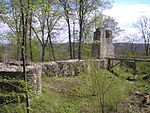Vogelherd Cave

The Vogelherd Cave (German: Vogelherdhöhle , or simply Vogelherd) is located in the eastern Swabian Jura, south-western Germany. This limestone karst cave came to scientific and public attention after the 1931 discovery of the Upper Palaeolithic Vogelherd figurines, attributed to paleo-humans of the Aurignacian culture. These miniature sculptures made of mammoth ivory rank among the oldest uncontested works of art of mankind. Because of the cultural importance of these sculptures and the cave's testimony to the development of Paleolithic art and culture, in 2017 the site became part of the UNESCO World Heritage Site called Caves and Ice Age Art in the Swabian Jura.
Excerpt from the Wikipedia article Vogelherd Cave (License: CC BY-SA 3.0, Authors, Images).Vogelherd Cave
Am Vogelherd, GVV Sontheim-Niederstotzingen
Geographical coordinates (GPS) Address Website Nearby Places Show on map
Geographical coordinates (GPS)
| Latitude | Longitude |
|---|---|
| N 48.55867 ° | E 10.19411 ° |
Address
Archäopark Vogelherd
Am Vogelherd 1
89168 GVV Sontheim-Niederstotzingen
Baden-Württemberg, Germany
Open on Google Maps










